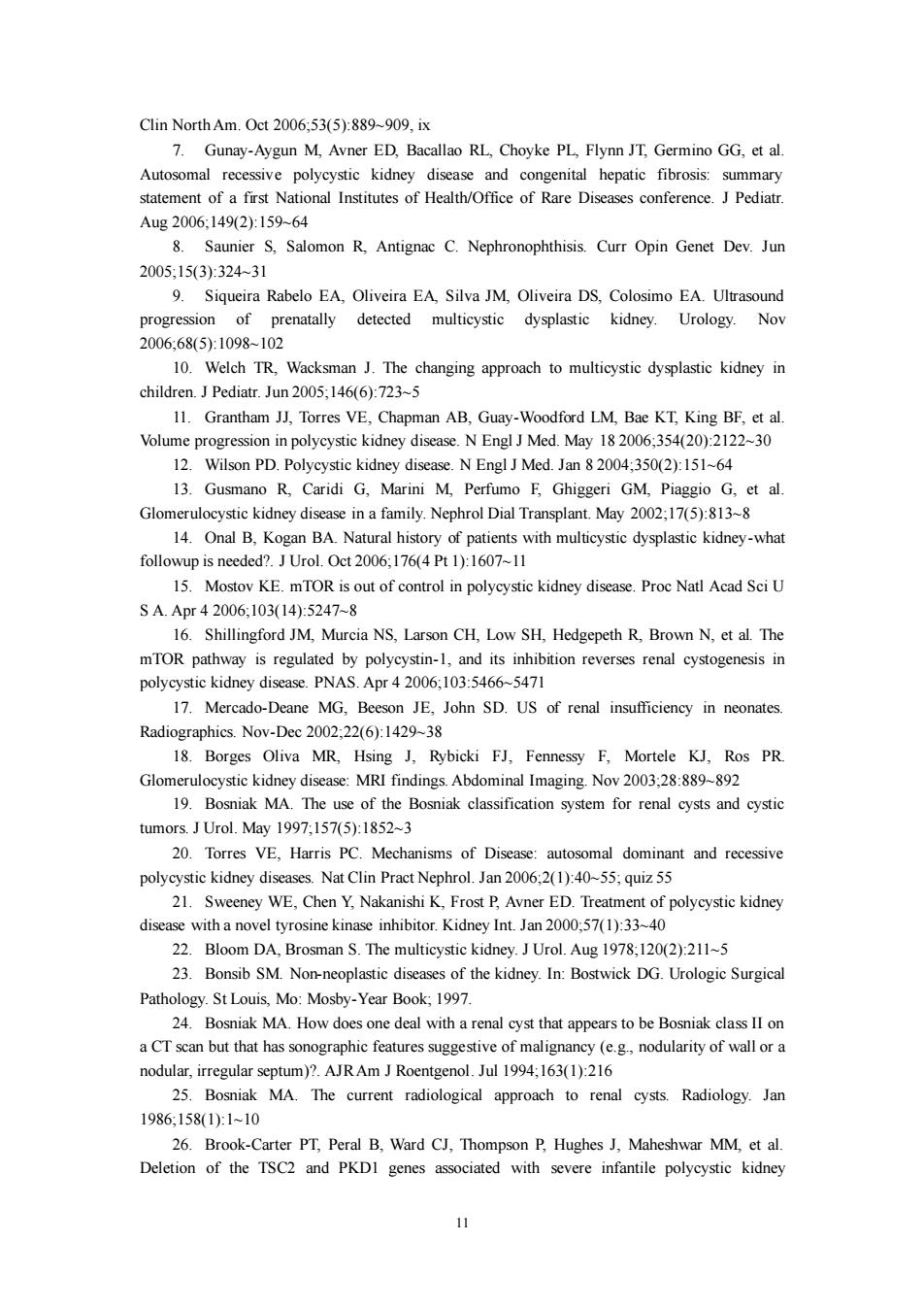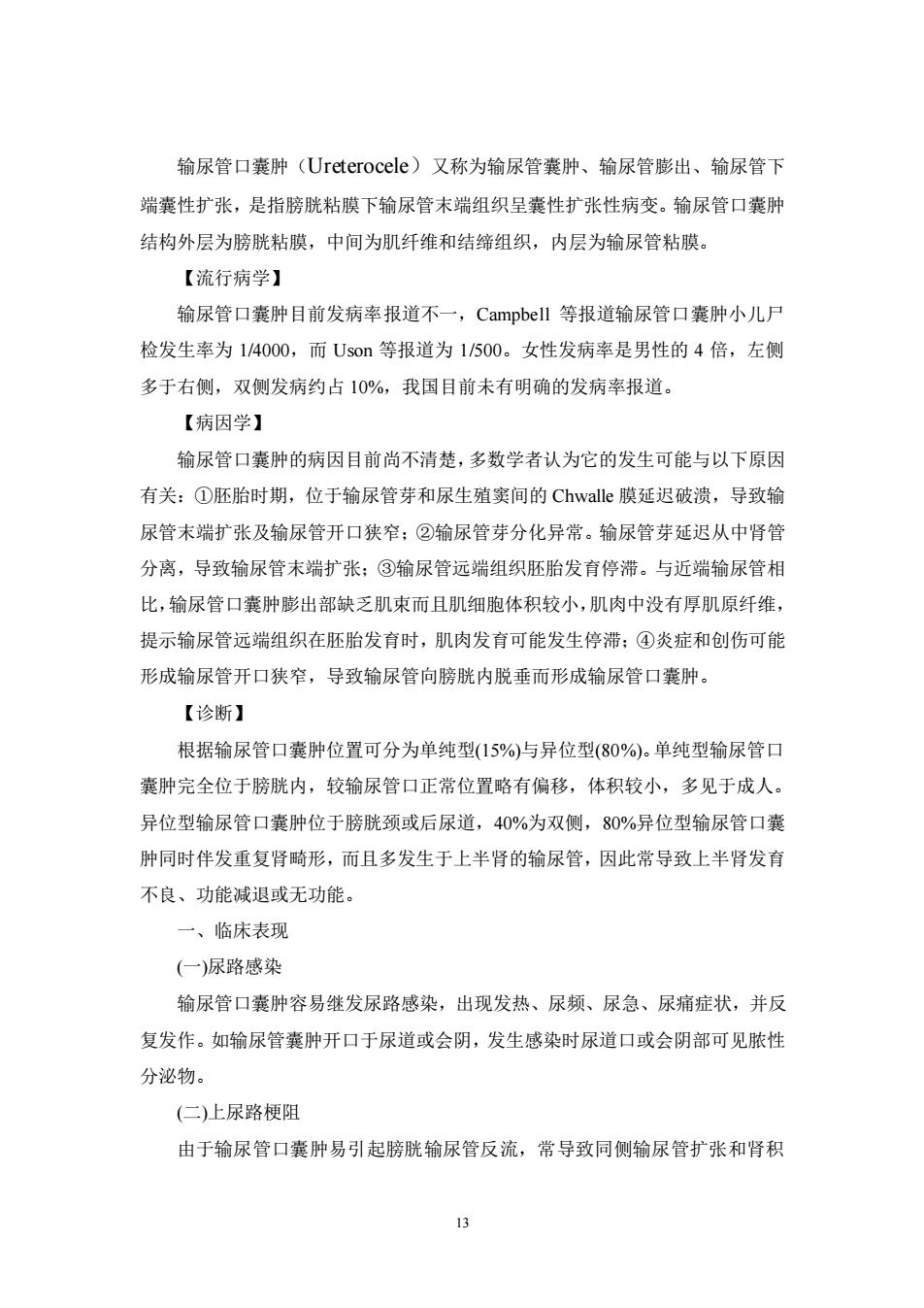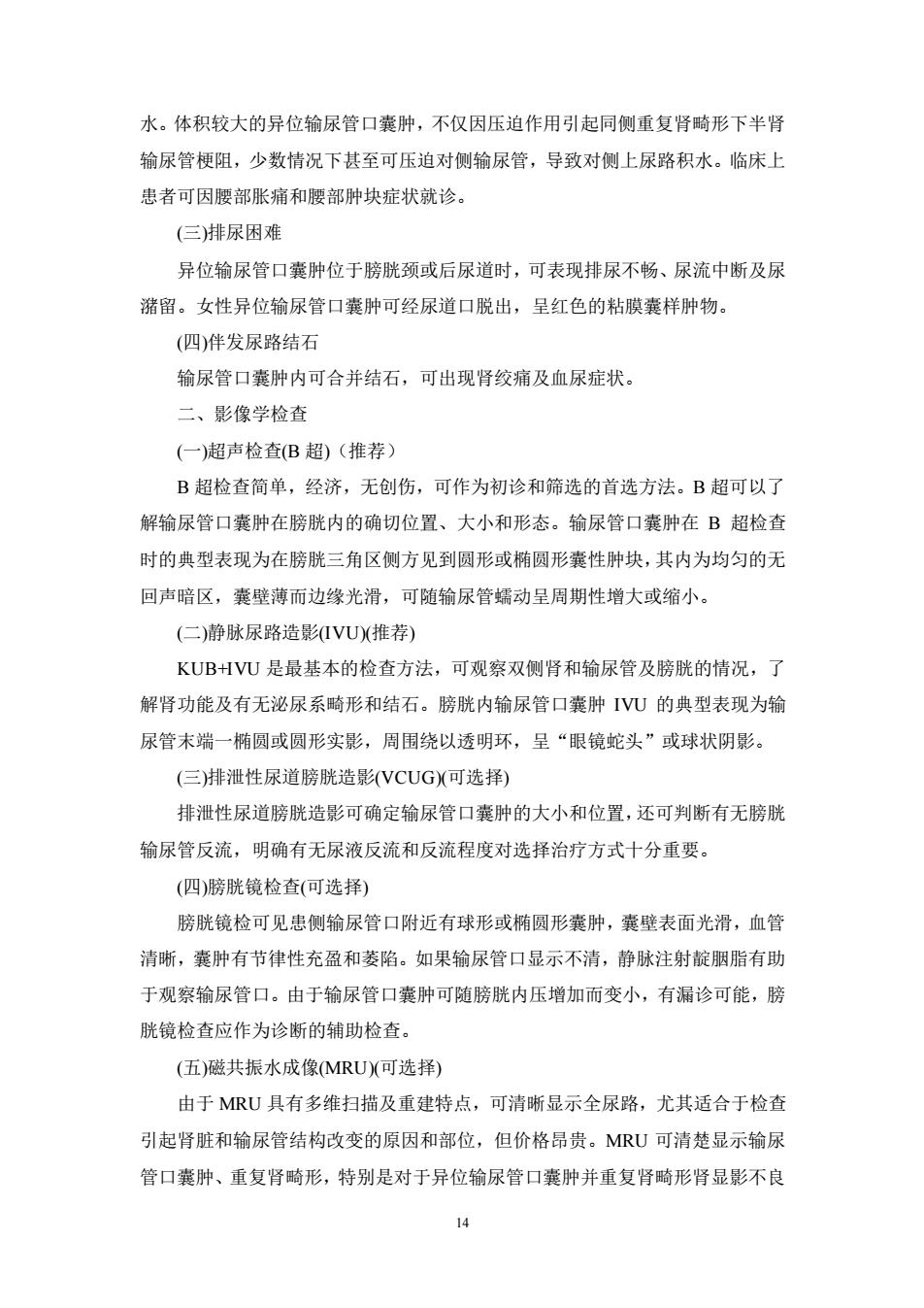
Clin NorthAm.Oct 2006:53(5):889-909,ix 7.Gunay-Aygun M,Avner ED.Bacallao RL Choyke PL Flynn JT,Germino GG,et al. Autosomal rec statement of a first National Institutes of Health/Office of Rare Diseases conference.J Pediatr Aug2006:149(2):15964 8.Saunier S.Salomon R.Antignac C.Nephronophthisis.Curr Opin Genet Dev.Jun 2005.15(3):324-31 0 Siqueira Rabelo EA.Oliveira EA.Silva JM,Oliveira DS.Colosimo EA.Ulrasound progression of prenatally detected multicystic dysplastic kidney. Urology.Nov 2006:68(5)1098-102 10.Welch TR,Wacksman J.The changing approach to multicystic dysplastic kidney in children.JPediatr.Jun2005:146(6):723-5 11.Grantham JJ,Torres VE,Chapman AB.Gua Volume progressio ic kidney disease.N Engl J Med.May 12006:354(20)1 12.Wilson PD.Polyeystic kidney disease.N Engl J Med.Jan 8 2004:350(2):151-64 13.Gusmano R,Caridi G,Marini M,Perfumo F,Ghiggeri GM,Piaggio G,et al. Glomerulocystic kidney disease in a family.Nephrol Dial Transplant.May 2002.17(5):813~8 14.Onal B.Kogan BA.Natural history of patients with multicystic dysplastic kidney-what 15.Mostov KE.mTOR is out of control in polycystic kidney disease.Proc Natl Acad SciU SA.Apr42006:10314):5247-8 16.Shillingford JM,Murcia NS,Larson CH,Low SH,Hedgepeth R,Brown N,et al.The mTOR pathway is regulated by polycystin-1.and its inhibition reverses renal cystogenesis in c kidney dis e PNAS Apr42006,103:5466-5471 17.Mercado-Deane MG,Beeson E,John SD.US of renal insuficiency in neonates Radiographics.Nov-Dec 2002:22(6):1429~38 18.Borges Oliva MR,Hsing J,Rybicki FJ,Fennessy F,Mortele KJ,Ros PR Glomerulocystic kidney disease:MRI findings.Abdominal Imaging Nov20:992 19.Bosniak MA.The use of the Bos sniak classification system for renal ysts and cystic tumors.JUrol.May 1997.157(5):1852-3 20.Torres VE.Harris PC.Mechanisms of Disease:autosomal dominant and recessive polycystic kidney diseases.Nat Clin Pract Nephrol.Jan62(1):40~55quiz55 21.Sweeney WE.Chen Y.Nakanishi K,Frost P Avner ED.Treatment of polycystic kidney disease with a novel tyrosine kinase inhibitor Kidney Int Jan 2000:57(1)33-40 Bloom DA,Brosman S.The multieystic kidney.JUrol.():11 23.Bonsib SM.Non-neoplastic diseases of the kidney.In:Bostwick DG.Urologic Surgica Pathology.St Louis,Mo:Mosby-Year Book:1997. 24.Bosniak MA.How does one deal with a renal cyst that appears to be Bosniak class II on a CT scan but that has sonographic features suggestive of malignancy (e.g nodularity of wallor a otum)?.AJRAm J Roentg o.Jul19941631):216 25.B9 niak MA The current radiological approach to renal eysts.Radiology.Jan 1986,158(1):1-10 26.Brook-Carter PT,Peral B.Ward CJ,Thompson P.Hughes J,Maheshwar MM,et al. Deletion of the TSC2 and PKDI genes associated with severe infantile polycystic kidney 11
11 Clin North Am. Oct 2006;53(5):889~909, ix 7. Gunay-Aygun M, Avner ED, Bacallao RL, Choyke PL, Flynn JT, Germino GG, et al. Autosomal recessive polycystic kidney disease and congenital hepatic fibrosis: summary statement of a first National Institutes of Health/Office of Rare Diseases conference. J Pediatr. Aug 2006;149(2):159~64 8. Saunier S, Salomon R, Antignac C. Nephronophthisis. Curr Opin Genet Dev. Jun 2005;15(3):324~31 9. Siqueira Rabelo EA, Oliveira EA, Silva JM, Oliveira DS, Colosimo EA. Ultrasound progression of prenatally detected multicystic dysplastic kidney. Urology. Nov 2006;68(5):1098~102 10. Welch TR, Wacksman J. The changing approach to multicystic dysplastic kidney in children. J Pediatr. Jun 2005;146(6):723~5 11. Grantham JJ, Torres VE, Chapman AB, Guay-Woodford LM, Bae KT, King BF, et al. Volume progression in polycystic kidney disease. N Engl J Med. May 18 2006;354(20):2122~30 12. Wilson PD. Polycystic kidney disease. N Engl J Med. Jan 8 2004;350(2):151~64 13. Gusmano R, Caridi G, Marini M, Perfumo F, Ghiggeri GM, Piaggio G, et al. Glomerulocystic kidney disease in a family. Nephrol Dial Transplant. May 2002;17(5):813~8 14. Onal B, Kogan BA. Natural history of patients with multicystic dysplastic kidney-what followup is needed?. J Urol. Oct 2006;176(4 Pt 1):1607~11 15. Mostov KE. mTOR is out of control in polycystic kidney disease. Proc Natl Acad Sci U S A. Apr 4 2006;103(14):5247~8 16. Shillingford JM, Murcia NS, Larson CH, Low SH, Hedgepeth R, Brown N, et al. The mTOR pathway is regulated by polycystin-1, and its inhibition reverses renal cystogenesis in polycystic kidney disease. PNAS. Apr 4 2006;103:5466~5471 17. Mercado-Deane MG, Beeson JE, John SD. US of renal insufficiency in neonates. Radiographics. Nov-Dec 2002;22(6):1429~38 18. Borges Oliva MR, Hsing J, Rybicki FJ, Fennessy F, Mortele KJ, Ros PR. Glomerulocystic kidney disease: MRI findings. Abdominal Imaging. Nov 2003;28:889~892 19. Bosniak MA. The use of the Bosniak classification system for renal cysts and cystic tumors. J Urol. May 1997;157(5):1852~3 20. Torres VE, Harris PC. Mechanisms of Disease: autosomal dominant and recessive polycystic kidney diseases. Nat Clin Pract Nephrol. Jan 2006;2(1):40~55; quiz 55 21. Sweeney WE, Chen Y, Nakanishi K, Frost P, Avner ED. Treatment of polycystic kidney disease with a novel tyrosine kinase inhibitor. Kidney Int. Jan 2000;57(1):33~40 22. Bloom DA, Brosman S. The multicystic kidney. J Urol. Aug 1978;120(2):211~5 23. Bonsib SM. Non-neoplastic diseases of the kidney. In: Bostwick DG. Urologic Surgical Pathology. St Louis, Mo: Mosby-Year Book; 1997. 24. Bosniak MA. How does one deal with a renal cyst that appears to be Bosniak class II on a CT scan but that has sonographic features suggestive of malignancy (e.g., nodularity of wall or a nodular, irregular septum)?. AJR Am J Roentgenol. Jul 1994;163(1):216 25. Bosniak MA. The current radiological approach to renal cysts. Radiology. Jan 1986;158(1):1~10 26. Brook-Carter PT, Peral B, Ward CJ, Thompson P, Hughes J, Maheshwar MM, et al. Deletion of the TSC2 and PKD1 genes associated with severe infantile polycystic kidney

disease--a contiguous gene syndrome.Nat Genet.Dec 1994:8(4):328~32 27.Chauveau D.DuvicC.Chretien Y,ParafF.Droz D.Melki Pet al Renal involvement in von Hippel-Lindau disease.Kidney Int Sep9:50():944-51 28.Clarke A,Hancock E,Kingswood C.Osborne JP.End-stage renal failure in adults with the tuberous sclerosis complex.Nephrol Dial Transplant.Apr 1999,14(4):988~91 29.Davidson AJ.Hartman DS.Chovke PL.Wagner BJ.Radiologic assessment of renal masses. implications for patient care.Radiology.Feb 1997()705 30.Fick GM,Johnson AM,Hammond WS,Gabow PA.Causes of death in autosomal dominant polyeystic kidney disease.JAm Soc Nephrol.Jun 1995:5(12):2048-56 31.Grantham JJ,Nair V,Winklhofer F.Cystic disease of the kidney.In:Brenner BM,ed. Brenner and Rector's the Kidney.6th ed.Philadelphia,Pa:WB Saunders Co:2000:1171~1200. 32.Israel GM,Bosniak MA.Follow-up CT of moderately complex cystic lesions of the ategory IIF).AJRAmJRo ntgenol..Scp2003,181(3):627-33 Israel GM,Hindman N.Bosniak MA.Evaluation of cystic renal masses:comparison of CT and MR imaging by using the Bosniak classification system.Radiology.May 2004:,231(2):365-71 34 Lang EK Macchia RI Gavle b Richter E Watson Ra Thomas r CT-guided biopsy of enal (Bo ak 3 and 2F):accuracy and ct on clin 35.Laube M,Hess B.Terrier F,Vock P.Jaeger P.[Prevalence of medullary sponge kidney in patients with and without nephrolithiasis].Schweiz Rundsch Med Prax.Oct 24 1995:8443:1224-30 36.Levine E.Slusher SL GranthamJ,Wetzel LH.Natural histor of acquired renal evstic in dialysis patients:a pospective longitudinal CT study.AJRAmJ Roentgenol.Ma 1991,156(3)y501-6 37.Lonergan GJ,Rice RR.Suarez ES.Autosomal recessive polycystic kidney disease: radiologic-pathologic correlation.Radiographics.May-Jun 2000:20(3):837-55 38.Matson MA,Cohen EP Acqu ed cystic kidney disease:occurrence,prevalence,and renal cancers Medi e(Baltin 990:69(4):217-26 39.Miller MA.Brown JJ.Renal cysts and cystic neoplasms Magn Reson Imaging Clin N Am.Feb1997:5(1):49-66 40.Ohlson L Normal collecting ducts:visualization at urography.Radiology.Jan 1989:1701P11:33-7 41.Ravine D,Gibson RN.Walker RG,Sheffield LJ,Kincaid-Smith P.Danks DM. diagnosti riteria for auosm dominant polycystic kidney disease 1.Lancet.Apr 2 1994:343(8901):824~7 42.Siegel CL McFarland EG,Brink JA,Fisher AJ,Humphrey P.Heiken JP CT of cystic renal masses:analysis of diagnostic performance and interobserver variation.AJR Am J Roentgenol Sep 1997-169(3)813-8 43.Wolf J Evaluation and management of solid and eystic renal masses JUrol Ap 1998,159(4):1120-33 44.Yent ER.Medullary sponge kidney.In:Schrier RE,Gottschalk CW.Disease of the Kidney.5th ed.Little Brown:Boston,Mass:1993:525-32. (三)输尿管口囊肿
12 disease--a contiguous gene syndrome. Nat Genet. Dec 1994;8(4):328~32 27. Chauveau D, Duvic C, Chretien Y, Paraf F, Droz D, Melki P, et al. Renal involvement in von Hippel-Lindau disease. Kidney Int. Sep 1996;50(3):944~51 28. Clarke A, Hancock E, Kingswood C, Osborne JP. End-stage renal failure in adults with the tuberous sclerosis complex. Nephrol Dial Transplant. Apr 1999;14(4):988~91 29. Davidson AJ, Hartman DS, Choyke PL, Wagner BJ. Radiologic assessment of renal masses: implications for patient care. Radiology. Feb 1997;202(2):297~305 30. Fick GM, Johnson AM, Hammond WS, Gabow PA. Causes of death in autosomal dominant polycystic kidney disease. J Am Soc Nephrol. Jun 1995;5(12):2048~56 31. Grantham JJ, Nair V, Winklhofer F. Cystic disease of the kidney. In: Brenner BM, ed. Brenner and Rector's the Kidney. 6th ed. Philadelphia, Pa: WB Saunders Co; 2000:1171~1200. 32. Israel GM, Bosniak MA. Follow-up CT of moderately complex cystic lesions of the kidney (Bosniak category IIF). AJR Am J Roentgenol. Sep 2003;181(3):627~33 33. Israel GM, Hindman N, Bosniak MA. Evaluation of cystic renal masses: comparison of CT and MR imaging by using the Bosniak classification system. Radiology. May 2004;231(2):365~71 34. Lang EK, Macchia RJ, Gayle B, Richter F, Watson RA, Thomas R. CT-guided biopsy of indeterminate renal cystic masses (Bosniak 3 and 2F): accuracy and impact on clinical management. Eur Radiol. Oct 2002;12(10):2518~24 35. Laube M, Hess B, Terrier F, Vock P, Jaeger P. [Prevalence of medullary sponge kidney in patients with and without nephrolithiasis]. Schweiz Rundsch Med Prax. Oct 24 1995;84(43):1224~30 36. Levine E, Slusher SL, Grantham JJ, Wetzel LH. Natural history of acquired renal cystic disease in dialysis patients: a prospective longitudinal CT study. AJR Am J Roentgenol. Mar 1991;156(3):501~6 37. Lonergan GJ, Rice RR, Suarez ES. Autosomal recessive polycystic kidney disease: radiologic-pathologic correlation. Radiographics. May-Jun 2000;20(3):837~55 38. Matson MA, Cohen EP. Acquired cystic kidney disease: occurrence, prevalence, and renal cancers. Medicine (Baltimore). Jul 1990;69(4):217~26 39. Miller MA, Brown JJ. Renal cysts and cystic neoplasms. Magn Reson Imaging Clin N Am. Feb 1997;5(1):49~66 40. Ohlson L. Normal collecting ducts: visualization at urography. Radiology. Jan 1989;170(1 Pt 1):33~7 41. Ravine D, Gibson RN, Walker RG, Sheffield LJ, Kincaid-Smith P, Danks DM. Evaluation of ultrasonographic diagnostic criteria for autosomal dominant polycystic kidney disease 1. Lancet. Apr 2 1994;343(8901):824~7 42. Siegel CL, McFarland EG, Brink JA, Fisher AJ, Humphrey P, Heiken JP. CT of cystic renal masses: analysis of diagnostic performance and interobserver variation. AJR Am J Roentgenol. Sep 1997;169(3):813~8 43. Wolf JS Jr. Evaluation and management of solid and cystic renal masses. J Urol. Apr 1998;159(4):1120~33 44. Yent ER. Medullary sponge kidney. In: Schrier RE, Gottschalk CW. Disease of the Kidney. 5th ed. Little Brown: Boston, Mass; 1993:525~32. (三)输尿管口囊肿

输尿管口囊肿(Ureterocele)又称为输尿管囊肿、输尿管膨出、输尿管下 端囊性扩张,是指膀胱粘膜下输尿管末端组织呈囊性扩张性病变。输尿管口囊肿 结构外层为膀胱粘膜,中间为肌纤维和结缔组织,内层为输尿管粘膜。 【流行病学】 输尿管口囊肿目前发病率报道不一,Campbell等报道输尿管口囊肿小儿尸 检发生率为14000,而Uso等报道为1/500。女性发病率是男性的4倍,左侧 多于右侧,双侧发病约占10%,我国目前未有明确的发病率报道。 【病因学】 输尿管口囊肿的病因目前尚不清楚,多数学者认为它的发生可能与以下原因 有关:①胚胎时期,位于输尿管芽和尿生殖窦间的Chwalle膜延迟破溃,导致输 尿管末端扩张及输尿管开口狭窄:②输尿管芽分化异常。输尿管芽延迟从中肾管 分离,导致输尿管末端扩张:③输尿管远端组织胚胎发育停滞。与近端输尿管相 比,输尿管口囊肿膨出部缺乏肌束而且肌细胞体积较小,肌肉中没有厚肌原纤维, 提示输尿管远端组织在胚胎发育时,肌肉发育可能发生停滞:④炎症和创伤可能 形成输尿管开口狭窄,导致输尿管向膀胱内脱垂而形成输尿管口囊肿。 【诊断】 根据输尿管口囊肿位置可分为单纯型(15%)与异位型(80%)。单纯型输尿管口 囊肿完全位于膀胱内,较输尿管口正常位置略有偏移,体积较小,多见于成人。 异位型输尿管口囊肿位于膀胱颈或后尿道,40%为双侧,80%异位型输尿管口囊 肿同时伴发重复肾畸形,而且多发生于上半肾的输尿管,因此常导致上半肾发育 不良、功能减退或无功能。 一、临床表现 (一)尿路感染 输尿管口囊肿容易继发尿路感染,出现发热、尿频、尿急、尿痛症状,并反 复发作。如输尿管囊肿开口于尿道或会阴,发生感染时尿道口或会阴部可见脓性 分泌物。 (仁)上尿路梗阻 由于输尿管口囊肿易引起膀胱输尿管反流,常导致同侧输尿管扩张和肾积 13
13 输尿管口囊肿(Ureterocele)又称为输尿管囊肿、输尿管膨出、输尿管下 端囊性扩张,是指膀胱粘膜下输尿管末端组织呈囊性扩张性病变。输尿管口囊肿 结构外层为膀胱粘膜,中间为肌纤维和结缔组织,内层为输尿管粘膜。 【流行病学】 输尿管口囊肿目前发病率报道不一,Campbell 等报道输尿管口囊肿小儿尸 检发生率为 1/4000,而 Uson 等报道为 1/500。女性发病率是男性的 4 倍,左侧 多于右侧,双侧发病约占 10%,我国目前未有明确的发病率报道。 【病因学】 输尿管口囊肿的病因目前尚不清楚,多数学者认为它的发生可能与以下原因 有关:①胚胎时期,位于输尿管芽和尿生殖窦间的 Chwalle 膜延迟破溃,导致输 尿管末端扩张及输尿管开口狭窄;②输尿管芽分化异常。输尿管芽延迟从中肾管 分离,导致输尿管末端扩张;③输尿管远端组织胚胎发育停滞。与近端输尿管相 比,输尿管口囊肿膨出部缺乏肌束而且肌细胞体积较小,肌肉中没有厚肌原纤维, 提示输尿管远端组织在胚胎发育时,肌肉发育可能发生停滞;④炎症和创伤可能 形成输尿管开口狭窄,导致输尿管向膀胱内脱垂而形成输尿管口囊肿。 【诊断】 根据输尿管口囊肿位置可分为单纯型(15%)与异位型(80%)。单纯型输尿管口 囊肿完全位于膀胱内,较输尿管口正常位置略有偏移,体积较小,多见于成人。 异位型输尿管口囊肿位于膀胱颈或后尿道,40%为双侧,80%异位型输尿管口囊 肿同时伴发重复肾畸形,而且多发生于上半肾的输尿管,因此常导致上半肾发育 不良、功能减退或无功能。 一、临床表现 (一)尿路感染 输尿管口囊肿容易继发尿路感染,出现发热、尿频、尿急、尿痛症状,并反 复发作。如输尿管囊肿开口于尿道或会阴,发生感染时尿道口或会阴部可见脓性 分泌物。 (二)上尿路梗阻 由于输尿管口囊肿易引起膀胱输尿管反流,常导致同侧输尿管扩张和肾积

水。体积较大的异位输尿管口囊肿,不仅因压迫作用引起同侧重复肾畸形下半肾 输尿管梗阻,少数情况下甚至可压迫对侧输尿管,导致对侧上尿路积水。临床上 患者可因腰部胀痛和腰部肿块症状就诊。 (三)排尿困难 异位输尿管口囊肿位于膀胱颈或后尿道时,可表现排尿不畅、尿流中断及尿 潴留。女性异位输尿管口囊肿可经尿道口脱出,呈红色的粘膜囊样肿物 (四)伴发尿路结石 输尿管口囊肿内可合并结石,可出现肾绞痛及血尿症状。 二、影像学检查 (一)超声检查B超)(推荐) B超检查简单,经济,无创伤,可作为初诊和筛选的首选方法。B超可以了 解输尿管口囊肿在膀胱内的确切位置、大小和形态。输尿管口囊肿在B超检查 时的典型表现为在膀胱三角区侧方见到圆形或椭圆形囊性肿块,其内为均匀的无 回声暗区,囊壁薄而边缘光滑,可随输尿管蠕动呈周期性增大或缩小。 (二)静脉尿路造影IVU(推荐) KUB+HVU是最基本的检查方法,可观察双侧肾和输尿管及膀胱的情况,了 解肾功能及有无泌尿系畸形和结石。膀胱内输尿管口囊肿VU的典型表现为输 尿管末端一椭圆或圆形实影,周围绕以透明环,呈“眼镜蛇头”或球状阴影。 (三)排泄性尿道膀胱造影VCUG(可选择) 排泄性尿道膀胱造影可确定输尿管口囊肿的大小和位置,还可判断有无膀胱 输尿管反流,明确有无尿液反流和反流程度对选择治疗方式十分重要 (四)膀胱镜检查(可选择) 膀胱镜检可见患侧输尿管口附近有球形或椭圆形囊肿,囊壁表面光滑,血管 清晰,囊肿有节律性充盈和菱陷。如果输尿管口显示不清,静脉注射靛胭脂有助 于观察输尿管口。由于输尿管口囊肿可随膀胱内压增加而变小,有漏诊可能,膀 胱镜检查应作为诊断的辅助检查。 (五)磁共振水成像MRU可选择) 由于MRU具有多维扫描及重建特点,可清晰显示全尿路,尤其适合于检查 引起肾脏和输尿管结构改变的原因和部位,但价格昂贵。MRU可清楚显示输尿 管口囊肿、重复肾畸形,特别是对于异位输尿管口囊肿并重复肾畸形肾显影不良
14 水。体积较大的异位输尿管口囊肿,不仅因压迫作用引起同侧重复肾畸形下半肾 输尿管梗阻,少数情况下甚至可压迫对侧输尿管,导致对侧上尿路积水。临床上 患者可因腰部胀痛和腰部肿块症状就诊。 (三)排尿困难 异位输尿管口囊肿位于膀胱颈或后尿道时,可表现排尿不畅、尿流中断及尿 潴留。女性异位输尿管口囊肿可经尿道口脱出,呈红色的粘膜囊样肿物。 (四)伴发尿路结石 输尿管口囊肿内可合并结石,可出现肾绞痛及血尿症状。 二、影像学检查 (一)超声检查(B 超)(推荐) B 超检查简单,经济,无创伤,可作为初诊和筛选的首选方法。B 超可以了 解输尿管口囊肿在膀胱内的确切位置、大小和形态。输尿管口囊肿在 B 超检查 时的典型表现为在膀胱三角区侧方见到圆形或椭圆形囊性肿块,其内为均匀的无 回声暗区,囊壁薄而边缘光滑,可随输尿管蠕动呈周期性增大或缩小。 (二)静脉尿路造影(IVU)(推荐) KUB+IVU 是最基本的检查方法,可观察双侧肾和输尿管及膀胱的情况,了 解肾功能及有无泌尿系畸形和结石。膀胱内输尿管口囊肿 IVU 的典型表现为输 尿管末端一椭圆或圆形实影,周围绕以透明环,呈“眼镜蛇头”或球状阴影。 (三)排泄性尿道膀胱造影(VCUG)(可选择) 排泄性尿道膀胱造影可确定输尿管口囊肿的大小和位置,还可判断有无膀胱 输尿管反流,明确有无尿液反流和反流程度对选择治疗方式十分重要。 (四)膀胱镜检查(可选择) 膀胱镜检可见患侧输尿管口附近有球形或椭圆形囊肿,囊壁表面光滑,血管 清晰,囊肿有节律性充盈和萎陷。如果输尿管口显示不清,静脉注射靛胭脂有助 于观察输尿管口。由于输尿管口囊肿可随膀胱内压增加而变小,有漏诊可能,膀 胱镜检查应作为诊断的辅助检查。 (五)磁共振水成像(MRU)(可选择) 由于 MRU 具有多维扫描及重建特点,可清晰显示全尿路,尤其适合于检查 引起肾脏和输尿管结构改变的原因和部位,但价格昂贵。MRU 可清楚显示输尿 管口囊肿、重复肾畸形,特别是对于异位输尿管口囊肿并重复肾畸形肾显影不良